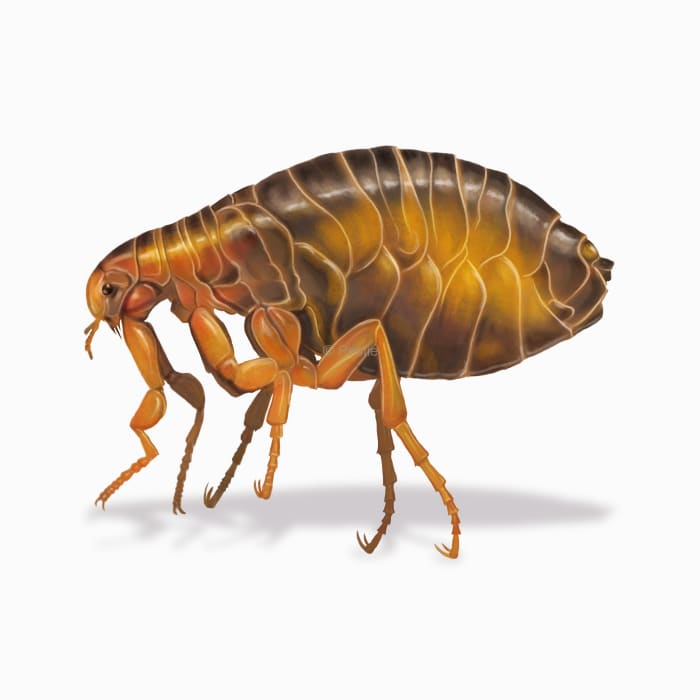How to identify and get rid of fleas

Uninvited guests: a closer look at the world of fleas and how to keep them at bay
“Adam Had ‘em” is known as the shortest poem ever written. The title of that poem? Fleas.
This gives us an idea of how long people have been dealing with these sneaky little pests.
Historically, fleas have been the culprit behind devastating epidemics around the world. Today, they continue to be a nuisance and problem with our pets and sometimes our homes.
Fleas are parasites that feed on the blood of warm-blooded animals.
While there are thousands of species of fleas around the world, the most common flea in the US is the cat flea. Despite its name, cat fleas can feed on the blood of most mammals, including us!
How to identify a flea
If you find an insect on your dog or cat, there’s a good chance it might be a flea. These tiny pests can be tricky to catch and look at since their powerful legs spring them away almost instantaneously.
A few things to look out for include its laterally flat body. Instead of being flat like a pancake, its sides are squished in, allowing it to navigate and jump through hair.
You also want to see if the pest on your pet or in your home has wings. Fleas are wingless and jump when disturbed. If filled with blood, they will look dark red to brown. When they are empty, they will be light to dark tan.
What does a flea bite look like?
Flea bites will be most likely on the legs, feet, calves, and ankles. The bites will look like round red dots, sometimes in small clusters, and often with a red halo around the bite. The bites can be very itchy, especially for those allergic to flea bites.
How big are fleas?
Fleas are very small insects and are only about 1/8th of an inch in length.
What other pests look like a flea?
A lot of small insects can be mistaken for fleas, including small beetles, lice, bed bugs, and springtails. Springtails in particular can look like fleas since they too can jump far by propelling themselves into the air. However, springtails don’t bite and they like to live in damp soil or moist areas with organic material.
Where do fleas live?
Typically, fleas live where their hosts are. That usually means in burrows, nests, or underneath shady brush where their hosts frequently rest or lay down.
In your home, fleas are going to be in the areas where you and your pets sleep or spend time. That includes sleeping mats, pet beds, carpets, rugs, furniture, or bedding.
How to get rid of fleas
Fleas can hitchhike on your indoor pets or sometimes get into your home if you have wildlife in or around your home. Adult fleas only make up about 5% of the flea population, so if you see one flea, chances are there are a handful of larvae and eggs out there ready to become a problem.
The best course of action is to prevent fleas from getting established on your pet, in their bedding, or your home. Regular pet baths can wash off adults and eggs, but further treatment is usually necessary to keep fleas from feeding on your cat or dog.
You can treat your pet with topical pesticides, chewable tablets, shampoos, or flea collars. One option for topical application is Pestie’s flea and tick treatment. If the infestation is really bad, you may want to talk to a veterinarian for further instructions.
If you discover fleas in your home, regularly and thoroughly vacuuming carpets is a must. You also want to seal the vacuum bag, throw it away, and take it away from the house. You don’t want to just dump the contents into a garbage bin in the home and then leave it. Carpets can also benefit from being steam cleaned and shampooed, so you know you have eliminated not only the adults but the larvae and eggs too. All pet bedding should also be washed in hot water and soap.
DIY traps, ultrasonic devices, or homemade sprays aren’t very effective at repelling or controlling flea issues.
Treat fleas with Pestie
If you're still having trouble keeping fleas away, the best option is to use a pro-grade, effective pest control solution like Pestie.
Pestie is a do-it-yourself pest control solution that's specially designed to keep fleas and other pests away from your home.
With Pestie, you can rest easy knowing that your living space is protected and free of creepy crawlies. And the best part? It's designed for people, pets, and the planet, so you can say goodbye to harsh chemicals and hello to peace of mind!
- Save hundreds compared to traditional annual pest plans
- People, pet, and planet-friendly
- Pro-grade customized formulas
Quick facts
How dangerous are Fleas?
Medium danger risk
Flea bites are mostly irritating and intensely itchy. Infections are rare unless the bites are scratched open and a secondary infection occurs. However, several species of fleas in the US are known to transmit diseases.
Cat fleas can spread typhus and cat scratch disease. Lesser common fleas like dog fleas can spread tapeworms in dogs, and the oriental rat flea still spreads the plague and typhus.
- Scientific name
Order - Siphonaptera
- Other common names
Cat Fleas, Dog Fleas
- Colors
Brown, red, tan
- Life span
2-3 months
- Diet
The blood of warm-blooded animals








